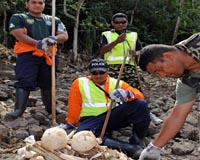| . |  |
. |
Padang, Indonesia (AFP) Oct 7, 2009 Villages buried in landslides triggered by last week's earthquake may be declared mass graves, Indonesian authorities said Wednesday as relief agencies battled to reach remote areas. Up to 400 people are believed to have been buried alive when hillsides collapsed in the 7.6-magnitude quake and obliterated four adjacent villages in Padang Pariaman district of Sumatra island. West Sumatra Governor Gamawan Fauzi said most of the dead would probably never be found or would be in such a state of decay that it would be better to leave them where they were. "If after umpteen days the bodies are broken, if we dig them up, probably their arms will break off, their legs will break off. It's no good," he told reporters in Padang, the provincial capital and worst-hit city. "If the community is willing, from a religious angle it is okay not to rebury them. So that area would be designated a mass grave." The official death toll from last Wednesday's quake stands at 704 but the Red Cross believes the final number will be more than 3,000, with hundreds of bodies still interred in the debris. One body was recovered from the flattened Ambacang Hotel in Padang on Wednesday, the 76th corpse pulled from the wreckage there since the quake. Military officer Haris Sarjana said 71 corpses remained buried at the site, which has been sprayed with disinfectant to prevent the spread of disease. Relief agencies are racing against time to get aid to farming villages in the rugged hinterland that are still cut off a week after the massive earthquake devastated parts of Sumatra. Around half a million people could be homeless, according to estimates by the United Nations and Red Cross based on the official figure of about 100,000 homes destroyed. UN humanitarian response coordinator Rachel Lavy said there was no shortage of aid supplies, and more was on the way aboard US warships expected to arrive off Sumatra by Friday. US aid officials in Padang said a field hospital with the capacity to treat up to 400 people was in operation but a military transport plane with 45 tonnes of supplies had been delayed and would arrive on Thursday. Indonesian Disaster Management Agency spokesman Priyadi Kardono said helicopters made six aid drops to isolated villages on Tuesday, with more flights planned for Wednesday. "Aid supplies are sufficient... though we welcome more. We have enough tents and about 19,000 tonnes of rice, which is enough to last four months," he said. Lavy said the biggest challenge was distribution, especially in mountain areas. "Agencies are still reporting pockets where they found people who say they haven't received any assistance," she told AFP. There were no signs of disease outbreaks, despite shortages of drinking water and the hundreds of decaying bodies still buried beneath the rubble, she said. Governor Fauzi denied that any areas had yet to receive aid, and blamed local authorities for any delays. "Where are the blockages in distribution? If it is blocked, probably it's between the local districts and the people," he said. "Just imagine, if 100,000 homes collapse, that's 500,000 people (homeless). If there are six people who aren't happy, 10 people who aren't happy, don't make that the news headline. "We're taking care of 500,000 people in a very short time." Australian military engineers had set up a plant to convert sea water into drinking water for up to 78,000 people in Padang, a city of a million people, officials said. The earthquake damaged a supply station that serviced 60 percent of Padang's water and people in the poorest part of the city have been using water from open canals and rivers. Share This Article With Planet Earth
Related Links Bringing Order To A World Of Disasters A world of storm and tempest When the Earth Quakes
 Tonga prisoners help out with tsunami relief work
Tonga prisoners help out with tsunami relief workNuku'Alofa (AFP) Oct 7, 2009 Prisoners from the Tongan island of Niuatoputapu have been helping with relief work after their jail was destroyed by last week's tsunami, officials said Wednesday. Nine people were killed, eight badly injured and hundreds left homeless when the tsunami smashed into the island following a huge earthquake. None of the island's 10 prisoners was hurt, despite their jail being smashed and ... read more |
|
| The content herein, unless otherwise known to be public domain, are Copyright 1995-2009 - SpaceDaily. AFP and UPI Wire Stories are copyright Agence France-Presse and United Press International. ESA Portal Reports are copyright European Space Agency. All NASA sourced material is public domain. Additional copyrights may apply in whole or part to other bona fide parties. Advertising does not imply endorsement,agreement or approval of any opinions, statements or information provided by SpaceDaily on any Web page published or hosted by SpaceDaily. Privacy Statement |